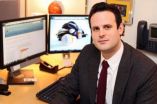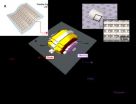(Press-News.org) Spraying reflective particles into the atmosphere to reflect sunlight and then stopping it could exacerbate the problem of climate change, according to new research by atmospheric scientists at the University of Washington.
Carrying out geoengineering for several decades and then stopping would cause warming at a rate that will greatly exceed that expected due to global warming, according to a study published Feb. 18 in Environmental Research Letters.
"The absolute temperature ends up being roughly the same as what it would have been, but the rate of change is so drastic, that ecosystems and organisms would have very little time to adapt to the changes," said lead author Kelly McCusker, who did the work for her UW doctoral thesis.
The study looks at solar radiation management, a proposed method of geoengineering by spraying tiny sulfur-based particles into the upper atmosphere to reflect sunlight. This is similar to what happens after a major volcanic eruption, and many experts believe the technique is economically and technically feasible. But continuous implementation over years depends on technical functioning, continuous funding, bureaucratic agreement and lack of negative side effects.
The UW team used a global climate model to show that if an business-as-usual emissions pathway is followed up until 2035, allowing temperatures to rise 1°C above the 1970-1999 mean, and then geoengineering is implemented for 25 years and suddenly stopped, global temperatures could rise by 4°C in the following three decades, a rate more than double what it would have been otherwise, and one that exceeds historical temperature trends.
"The rate of standard projected global warming alone is going to be really detrimental to a lot of organisms, so if you increase that by a factor of 2 to 3, then those organisms are going to have an even harder time adapting or migrating," said McCusker, now a postdoctoral researcher at the University of Victoria in Canada.
The results build on recent work led by British researchers pointing to the risk of implementing and then stopping geoengineering. That study compared several climate models, showing that the result is not specific to any one model. The UW researchers used a single model with a more realistic scenario, where instead of simply decreasing the strength of the sun they actually simulated sulfate particles to stabilize the temperature, allowing a more precise look at the spatial and seasonal pattern of the response.
"The changes that will be needed to adapt to a warmer climate are really profound," said co-author David Battisti, a UW professor of atmospheric sciences. "The faster the climate changes, the less time farmers have to develop new agricultural practices, and the less time plants and animals have to move or evolve."
The total amount of warming after stopping geoengineering would be largest in winter near the poles, but compared to typical historical rates of change they found that changes would be most extreme in the tropics in summertime, where there is usually very little temperature variation.
"According to our simulations, tropical regions like South Asia and sub-Saharan Africa will be hit particularly hard, the very same regions that are home to many of the world's most food insecure populations," McCusker said. "The potential temperature changes also pose a severe threat to biodiversity."
The researchers looked at different variables and found that the rate of warming is largely determined by the length of time that geoengineering is deployed and the amount of greenhouse gases emitted during that time, rather than by how sensitive the climate is to changes in greenhouse-gas concentrations.
"If we must geoengineer, it does not give us an excuse to keep emitting greenhouse gases," McCusker said. "On the contrary, our results demonstrate that if geoengineering is ever deployed, it's imperative that greenhouse gases be reduced at the same time to reduce the risk of rapid warming."
The research was funded by the Tamaki Foundation, the National Science Foundation and the James S. McDonnell Foundation. Other co-authors are Cecilia Bitz, a UW professor of atmospheric sciences, and Kyle Armour, a former UW doctoral student now at the Massachusetts Institute of Technology.
INFORMATION:
For more information, contact McCusker at 250-363-3456 or kemccusk@uvic.ca or Battisti at 206-543-2019 or battisti@uw.edu.
Embarking on geoengineering, then stopping, would speed up global warming
2014-02-18
ELSE PRESS RELEASES FROM THIS DATE:
In fight against teen prescription drug abuse, one-two punch wins
2014-02-18
DURHAM, N.C. -- Programs that aim to curb teen prescription drug abuse have vastly differing effectiveness, ranging from big drops in drug abuse to no measurable effect, according to a new study of 11,000 teenagers by researchers at Duke and Pennsylvania State universities.
The best results came from pairing a school-based program with a home-based intervention, resulting in a 10 percent decrease in abuse rates. By contrast, most school-based programs were ineffective when used by themselves, with just one exception.
The six-year study is among the first to measure ...
Research team establishes benchmark set of human genotypes for sequencing
2014-02-18
Led by biomedical engineer Justin Zook of the National Institute of Standards and Technology, a team of scientists from Harvard University and the Virginia Bioinformatics Institute of Virginia Tech has presented new methods to integrate data from different sequencing platforms, thus producing a reliable set of genotypes to benchmark human genome sequencing.
"Understanding the human genome is an immensely complex task and we need great methods to guide this research," Zook says. "By establishing reference materials and gold standard data sets, scientists are one step closer ...
Smartphone app aids college-age women in abusive relationships
2014-02-18
COLUMBIA, Mo. –Women between the ages of 18 and 24 are at the highest risk for dating violence, according to the Centers for Disease Control and Prevention. However, these women are less likely than older adults to seek formal safety resources and instead look to peers or technology for help and advice. In an effort to connect more young women with safety information, University of Missouri researchers collaborated with Johns Hopkins University School of Nursing and the One Love Foundation to develop the "One Love My Plan" smartphone application, an interactive tool that ...
Breakthrough development of flexible 1D-1R memory cell array
2014-02-18
With the introduction of curved smartphones, flexible electronic goods are gradually moving to the center stages of various markets. Flexible display technology is the culmination of the latest, cutting-edge electric cell device technology. Developing such products, however, requires not only a curved display, but also operational precision of other parts, including the memory, in a flexible state.
Dr. Tae-Wook Kim at KIST announced their successful development of a 64-bit memory array using flexible and twistable carbon nano material and organo-polymer compound, which ...
Medicare beneficiaries return to emergency rooms after nursing home discharge
2014-02-18
Nursing homes are widely used by Medicare beneficiaries who require rehabilitation after hospital stays. But according to a recent study led by a researcher at the University of North Carolina at Chapel Hill School of Nursing, a high percentage of Medicare patients who are discharged from nursing homes will return to the hospital or the emergency room within 30 days.
"Nearly two million older adults use this benefit every year," said assistant professor Mark Toles, the first author of the study. "Before this study, we didn't recognize the large number of older adults ...
Healthy Lunchbox Challenge helps influence healthy eating habits in children
2014-02-18
AUDIO:
Falon Tilley and Michael W. Beets discuss the successful implementation of the Healthy Lunchbox Challenge, an innovative theory and incentive-based program, at four large-scale, community-based summer day camps. They observed...
Click here for more information.
PHILADELPHIA, PA, February 18, 2014 – During the school year, 21 million children receive free or reduced-price lunches, yet less than 10% of those children participate in the Department of Agriculture's Summer ...
Metal in the heart is non-hazardous to health
2014-02-18
Jena (Germany) A trousers button, a coin or a watch can be dangerous for people with a nickel allergy. Approximately 1 in 10 Germans is allergic to the metal. "This raises the question of the safety of medical implants containing nickel," explains Professor Dr. Markus Rettenmayr of the Friedrich Schiller University Jena (Germany). Nickel-titanium alloys are increasingly used as material for cardiovascular implants in minimal invasive surgery. Once implanted, nickel-titanium alloys can release small amounts of nickel due to corrosion phenomena, the holder of the Chair of ...
Investment bankers lead businesses to better mergers, acquisitions
2014-02-18
BUFFALO, N.Y. – Corporations with board directors who have investment banking experience are more likely to acquire other businesses – and make better acquisitions when they do – according to a new study from the University at Buffalo School of Management.
Forthcoming in the Journal of Financial Economics, the study found that directors with investment banking experience help their firms to select better businesses to acquire, more accurately determine the value of the target business and either reduce reliance on mergers and acquisition consultants or negotiate lower ...
Molecular biology mystery unravelled
2014-02-18
The nature of the machinery responsible for the entry of proteins into cell membranes has been unravelled by scientists, who hope the breakthrough could ultimately be exploited for the design of new anti-bacterial drugs.
Groups of researchers from the University of Bristol and the European Molecular Biology Laboratory (EMBL) used new genetic engineering technologies to reconstruct and isolate the cell's protein trafficking machinery.
Its analysis has shed new light on a process which had previously been a mystery for molecular biologists.
The findings, published today ...
Personality and spaces, remaking love, meaning in life, and commonsense morality
2014-02-18
People and spaces, the tragedy of commonsense morality, myths about meaning of life, and remaking love were four themes at the Society for Personality and Social Psychology (SPSP) conference in Austin. Researchers presented new work, showing how psychology reaches into our everyday lives. Video from four of these talks is now available online.
Highlights include:
Sam Gosling of the University of Texas-Austin described how the link between our emotions and spaces is is inseparable. As such, our spaces say a lot about us. In new work, Gosling and colleagues identified ...



